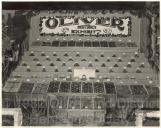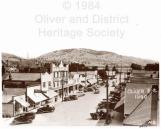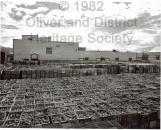1
By the 1930's, Oliver had become well-known for its excellent vegetable and soft fruit, specifically, its cantaloupe. A decline in farm and orcharding markets prompted change in the BC Fruit-Growers' Association's strategies and organization. As many growers had joined the organization on the promise of increased profits rather than its principles, a great amount of drama would ensue as strategies and principles of the organization were adapted and applied.2
Oliver Fruit exhibit in New Westminster20th Century, Circa mid-1920's
New Westminster, British Columbia, Canada
 Credits:
Credits:Stride Studios, New Westminster
3
Prior to 1931, the five-year average value of a box of apples was $1.29. In 1931, it was determined by the Supreme Court of Canada that the taxes and fees applied by the Produce Marketing Act were inconstitutional. A reliance on the government-monitored marketing had developed, and repercussions as a result of the Marketing Act's dissolution were felt throughout the orcharding industry.4
Oliver Co-op crew20th Centur, Circa 1930's
Oliver, British Columbia, Canada
 Credits:
Credits:Corbishley, Don
5
With the centralized distribution system dismantled, farmers and orchardists quickly felt the effects of an unregulated market. The price of apples fell by over 33% from 1931 to 1932, and another drop of 22% was felt from 1932 to 1933. Apples were at an all-time low, priced at just $0.68/box, and other fruits and produce felt similar effects.6
Oliver Co-Op Banquet20th Century, Circa Late 1940's
Oliver, British Columbia, Canada
 Credits:
Credits:Reinhart, Edith
7
Growers needed a minimum price of 95 cents a box to break even on the year. Because of the dismal $0.68 price of a box of apples in 1933, orchardists protested their declining profits by threatening to leave apples on the trees if the government could not guarantee at least 1 cent/ pound. The federal government heard the growers' plight, and responded by enacting a Natural Products Marketing Act, which would again be overturned by the Supreme Court for invading provincial powers. British Columbia's government quickly responded by amending its own act to only cover fruits sold within the province.In 1939, BC Tree Fruits was granted full control over sales. BC farmers finally had their centralized sales agency, and a promise of market protection from the province.
9
The 1940's were, by far, the most profitable period that growers in the Oliver area have ever experienced to date. A number of prairie farmers were retiring during this period, creating unmet market demand. This, combined with waves of German immigrants, created absolutely perfect conditions for a centralized selling agency. The price of apples increased by 114% from 1939 to 1945, even though a 40% increase in production would have normally decimated prices. Because more apples were being sold, and at a higher price, gross profits during the forties were nearly three-times what they were 10 years previous.10
Oliver's Main Street20th Century, Circa 1940
Oliver, British Columbia, Canada
 Credits:
Credits:Kelowna Photo Bank
11
The sharp rise in produce demand also increased the value of farmland, and many farmers sought to capitalize on the newfound value of their land. They supposed that by subdividing their plots, they could sell plots for luxury profit and keep a small portion of land to sustain them. Indeed, with the jump in demand for farm produce, smaller orchards could still yield enough money to be profitable. As the 1940's boom settled, however, these smaller plots quickly became economically unfeasable, and both buyer and seller had trouble making sufficient profit from the divided lots.12
Boxed Apples outside of packing house20th Century, Circa 1940's
Oliver, British Columbia, Canada
 Credits:
Credits:C. Scott Photography
13
While Oliver's early years proved a bumpy road for orchardists, the reprieve of the 1940's and the marketing aid from the BC Fruit Growers' Association would help to pull farmers through the rough. This time had, however, also exposed the weaknesses of the BCFGA's systems, and the future would bring into question the sustainability of their beliefs.14
Newspaper Advertisement for Oliver-Osoyoos Co-op Growers' Association20th Century, Circa 1981
Oliver, British Columbia, Canada
 Credits:
Credits:The Oliver Chronicle
